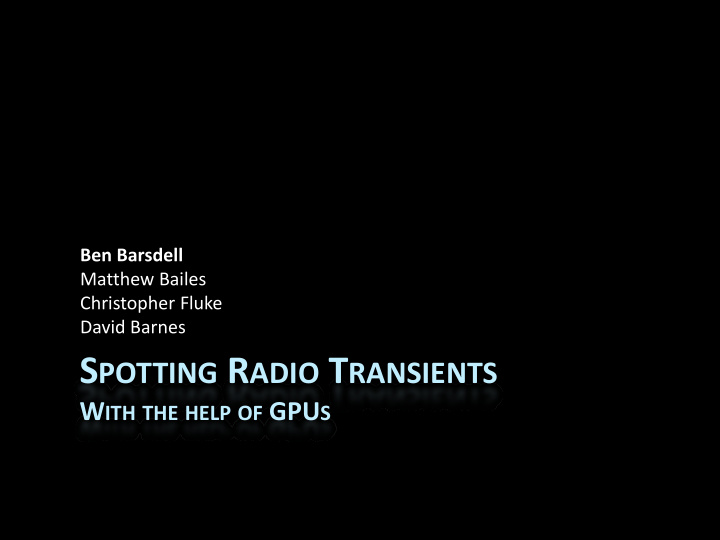



Ben Barsdell Matthew Bailes Christopher Fluke David Barnes S POTTING R ADIO T RANSIENTS W ITH THE HELP OF GPU S
Background � High Time Resolution Universe (HTRU) survey � Running since 2008, now entering deep phase � Uses the Parkes 64m radio telescope � Located in remote NSW, Australia � Goal is to discover new pulsars and radio transients � (And diamond planets!) Survey specs 400 MHz BW @ 1381.8 MHz 1024 freq. channels 64 μ s time resolution 2 ‐ bit sampling
Multi ‐ beam receiver Event Follow ‐ up observation Parkes Swinburne Freq. Filterbank data Time RFI removal Freq. Masked data Time Incoherent dedispersion Dedispersed DM List of time series candidates Time Signal search Ben Barsdell ‐ ADASS 2011
The Plan � Current pipeline takes > 30 mins per 10 min observation � Necessitates off ‐ line processing � Means transfers, tapes and long waits � Would like to speed things up to real ‐ time � Instant feedback and follow ‐ up observations � Triggered baseband data dumps � How to do it? � Time to bring out the heavy artillery… Ben Barsdell ‐ ADASS 2011
The GPU Ben Barsdell ‐ ADASS 2011
Telescope receiver beams Event Follow ‐ up observation Parkes Swinburne Freq. Filterbank data Time RFI removal Freq. Masked data Time Incoherent dedispersion Dedispersed DM List of time series candidates Time Signal search Ben Barsdell ‐ ADASS 2011
RFI The detection mitigation pipeline Incoherent dedispersion Baseline removal Fourier search Single pulse search Fourier transform Matched filter Harmonic summing RFI mitigation Sigma clip Report candidates Ben Barsdell ‐ ADASS 2011
RFI mitigation � Interference is a big problem � No easy solution � Military radar too useful www.clker.com � Prime ‐ time TV too popular � Some things can be done � Sigma clipping � Spectral kurtosis � Coincidence rejection Ben Barsdell ‐ ADASS 2011
Coincidence rejection � Use multi ‐ beam receiver as reference antennas � Assume RFI is not localised � Apply simple coincidence criteria: � E.g., 3 σ in 4+ beams => RFI � Or use Eigen ‐ decomposition approach � Run on GPU as a straightforward transform � RFI_mask[i] = is_RFI(multibeam_data[i]) � Note: Eigen ‐ decomp method makes is_RFI() trickier Ben Barsdell ‐ ADASS 2011
Dedispersion Dispersed signal Broadband signal ISM Radio Frequency (MHz) Frequency (MHz) source e ‐ ? Phase Phase � Unknown distance => search through DM space � Pick DM, dedisperse, search, repeat � ~ 1200 DM trials Ben Barsdell ‐ ADASS 2011
Dedispersion � Computationally intensive problem � Biggest time ‐ consumer � Runs really well on a GPU � Lots of parallelism � High arithmetic intensity � Good memory access patterns � No branching Ben Barsdell ‐ ADASS 2011
Other algorithms � Baseline removal � Subtract running mean � Port to GPU using parallel prefix sum � Matched filtering � Convolve with 1D boxcar � Can also use parallel prefix sum � Sigma cut + peak find � Threshold and segment � Port to GPU using segmented reduction Ben Barsdell ‐ ADASS 2011
Preliminary results � Dedispersion: 20 mins � 2.5 mins � Using ‘direct’ method on 1 Tesla C2050 GPU � Details in Barsdell et al. (refereed) � Nearly completed porting other algorithms � Goal of 10 mins well within reach! Ben Barsdell ‐ ADASS 2011
Looking ahead � Real ‐ time radio transient detection promises to � Simplify the data processing procedure � Enable immediate follow ‐ up observations � Allow capture of high ‐ resolution baseband data for significant events � Catch things like the ‘Lorimer burst’ as they happen! Ben Barsdell ‐ ADASS 2011
Merci! Ben Barsdell ‐ ADASS 2011
Hardware configuration Node Operation 1 Recv 2 beams Dedisperse Send DMs Recv beams Continue… . . . 2 Send DMs Recv beams . . . . . . . 3 Recv beams . . 4 Recv beams . . . Ben Barsdell ‐ ADASS 2011
Recommend
More recommend